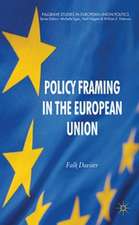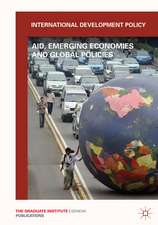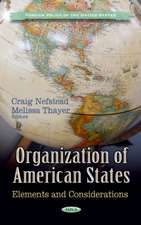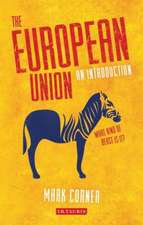NATO Beyond 9/11: The Transformation of the Atlantic Alliance: New Security Challenges
Editat de E. Hallams, L. Ratti, B. Zylaen Limba Engleză Hardback – 26 noi 2013
| Toate formatele și edițiile | Preț | Express |
|---|---|---|
| Paperback (1) | 388.13 lei 6-8 săpt. | |
| Palgrave Macmillan UK – 2013 | 388.13 lei 6-8 săpt. | |
| Hardback (1) | 395.47 lei 6-8 săpt. | |
| Palgrave Macmillan UK – 26 noi 2013 | 395.47 lei 6-8 săpt. |
Din seria New Security Challenges
- 15%
 Preț: 636.94 lei
Preț: 636.94 lei - 15%
 Preț: 580.68 lei
Preț: 580.68 lei -
 Preț: 390.63 lei
Preț: 390.63 lei -
 Preț: 381.59 lei
Preț: 381.59 lei -
 Preț: 428.07 lei
Preț: 428.07 lei - 15%
 Preț: 644.95 lei
Preț: 644.95 lei -
 Preț: 386.61 lei
Preț: 386.61 lei -
 Preț: 391.61 lei
Preț: 391.61 lei -
 Preț: 389.88 lei
Preț: 389.88 lei -
 Preț: 385.84 lei
Preț: 385.84 lei - 15%
 Preț: 649.06 lei
Preț: 649.06 lei - 15%
 Preț: 699.77 lei
Preț: 699.77 lei -
 Preț: 383.93 lei
Preț: 383.93 lei -
 Preț: 390.63 lei
Preț: 390.63 lei -
 Preț: 388.13 lei
Preț: 388.13 lei -
 Preț: 382.18 lei
Preț: 382.18 lei -
 Preț: 392.60 lei
Preț: 392.60 lei -
 Preț: 388.72 lei
Preț: 388.72 lei -
 Preț: 387.38 lei
Preț: 387.38 lei - 15%
 Preț: 695.70 lei
Preț: 695.70 lei - 15%
 Preț: 584.43 lei
Preț: 584.43 lei -
 Preț: 383.93 lei
Preț: 383.93 lei -
 Preț: 388.52 lei
Preț: 388.52 lei -
 Preț: 384.86 lei
Preț: 384.86 lei - 18%
 Preț: 726.37 lei
Preț: 726.37 lei - 15%
 Preț: 697.97 lei
Preț: 697.97 lei -
 Preț: 384.09 lei
Preț: 384.09 lei -
 Preț: 388.13 lei
Preț: 388.13 lei -
 Preț: 385.47 lei
Preț: 385.47 lei - 15%
 Preț: 640.88 lei
Preț: 640.88 lei -
 Preț: 385.84 lei
Preț: 385.84 lei -
 Preț: 383.93 lei
Preț: 383.93 lei -
 Preț: 382.75 lei
Preț: 382.75 lei -
 Preț: 389.70 lei
Preț: 389.70 lei -
 Preț: 382.95 lei
Preț: 382.95 lei -
 Preț: 387.38 lei
Preț: 387.38 lei -
 Preț: 386.81 lei
Preț: 386.81 lei
Preț: 395.47 lei
Nou
Puncte Express: 593
Preț estimativ în valută:
75.67€ • 79.01$ • 62.63£
75.67€ • 79.01$ • 62.63£
Carte tipărită la comandă
Livrare economică 04-18 aprilie
Preluare comenzi: 021 569.72.76
Specificații
ISBN-13: 9780230391215
ISBN-10: 0230391214
Pagini: 347
Ilustrații: X, 347 p.
Dimensiuni: 140 x 216 x 28 mm
Greutate: 0.59 kg
Ediția:2013
Editura: Palgrave Macmillan UK
Colecția Palgrave Macmillan
Seria New Security Challenges
Locul publicării:London, United Kingdom
ISBN-10: 0230391214
Pagini: 347
Ilustrații: X, 347 p.
Dimensiuni: 140 x 216 x 28 mm
Greutate: 0.59 kg
Ediția:2013
Editura: Palgrave Macmillan UK
Colecția Palgrave Macmillan
Seria New Security Challenges
Locul publicării:London, United Kingdom
Cuprins
Introduction PART I: A NEW PARADIGM FOR NATO? 1. NATO after 9/11: Theoretical Perspectives; Mark Webber 2. Reflections on 9/11: A View from NATO; Micheal Ruhle 3. A Sense of Return: A Sense of Return: NATO's Libyan Intervention in Perspective; Carl Hodge PART II: THE TRANSFORMATION OF NATO 4. 'Déjà vu all over again`? September 11 2001 and NATO Military Transformation; Terry Teriff 5. NATO in Afghanistan; Tim Bird 6. Just an 'Internal Exercise?' NATO and the 'New' Security Challenges; Magnus Petersson 7. Fine Words, Few Answers: NATO's not so new New Strategic Concept; Steve Marsh & Alan Dobson 8. Pooling, Sharing and Specialising: The Age of Austerity ad the Euro-Atlantic Security Architecture; Magnus Christiansson 9. At the End of its Tether? NATO's Intervention in Libya; Jeff Michaels PART III: RELATIONSHIPS AND PARTNERSHIPS 10. Between Hope and Realism: the US, NATO and a Transatlantic Bargain for the 21st Century; Ellen Hallams 11. A Bipolar Alliance for a Multipolar World: NATO and the EU; Sven Biscop 12. NATO–Russia Relations after 9/11: New Challenges, Old Issues; Luca Ratti 13. NATO's Global Partnerships - A Haphazard Strategy?; Trine Flockhart 14. NATO and Interorganizational Cooperation; Bastian Giegerich PART IV: CONCLUSION - NATO'S RETRENCHMENT?
Recenzii
'For much of its existence, NATO had a very clear deterrence mission which did not oblige it to move around very much. However, in more recent times, the Alliance has taken on a broad range of missions and in many different parts of the world. Arguably, these missions, extending from ground operations in Afghanistan to maritime operations in the Mediterranean and Gulf, and involving cooperation with a large number of partner countries from across the globe, have made NATO an even more visible and important organization than it was during the Cold War. Yet as NATO's mission in Afghanistan winds down, and as the European Allies confront major defence cuts and a shift of attention by the US to the Asia Pacific, can NATO remain a global actor? Do the enduring strengths of the Alliance continue to outweigh the many challenges it faces in adapting to the new spectrum of 21st century security threats, such as cyber attacks, terrorism, or the proliferation of weapons of mass destruction? Do the Allies have the political will and capabilities to address these issues together? As the debate on NATO's future gets under way, this book is the essential guide for anyone - whether policy maker, practitioner or student - who wants to understand where the Alliance is today and where it will be in the future.'
- Jamie Shea, NATO Deputy Assistant Secretary General for Emerging Security Challenges
"NATO's capacity for change is once again on the agenda now that its engulfingand prolonged combat mission in Afghanistan is about to end. This timely and important book traces the wider effects of the September 2001 terrorist attacks on the Alliance and how its future remains intimately tied to its past. It masterfully combines reflections on 'big change' with insights into NATO policy issues and is certain to provoke new thinking on the Alliance."
- Sten Rynning, University of Southern Denmark
- Jamie Shea, NATO Deputy Assistant Secretary General for Emerging Security Challenges
"NATO's capacity for change is once again on the agenda now that its engulfingand prolonged combat mission in Afghanistan is about to end. This timely and important book traces the wider effects of the September 2001 terrorist attacks on the Alliance and how its future remains intimately tied to its past. It masterfully combines reflections on 'big change' with insights into NATO policy issues and is certain to provoke new thinking on the Alliance."
- Sten Rynning, University of Southern Denmark
Notă biografică
Mark Webber, University of Birmingham, UKMichael Rühle, NATO's Emerging Security Challenges DivisionCarl Cavanagh Hodge, University of British Columbia-Okanagan, CanadaTerry Terriff, University of Calgary, CanadaTim Bird, King's College London, UKJeffrey H. Michaels, King's College London, UKMagnus Petersson, Norwegian Institute for Defence Studies, NorwaySteve Marsh, Cardiff University, UKAlan Dobson, University of Dundee, UKMagnus Christiansson, Swedish National Defence College, SwedenSven Biscop, Egmont Royal Institute for International Relations in Brussels, BelgiumTrine Flockhart, Danish Institute for International StudiesBastian Giegerich, Bundeswehr Centre for Military History and Social Sciences

















